The engine is the heart of every powered aircraft. In the case of the SBD it was the Wright R-1820 “Cyclone 9” (the “G“ model). In fact, this engine was one of the “workhorses” of the 1930s: designed in 1931, it was used in many aircraft, especially in the legendary DC-3. “Cyclone” was a reliable, fuel-saving unit for the Navy basic scout type. (Remember that the “Dauntless” was not only the bomber: it was also a scout airplane
[1]). In general, the R-1820 is a classic nine-cylinder, single-row radial engine:
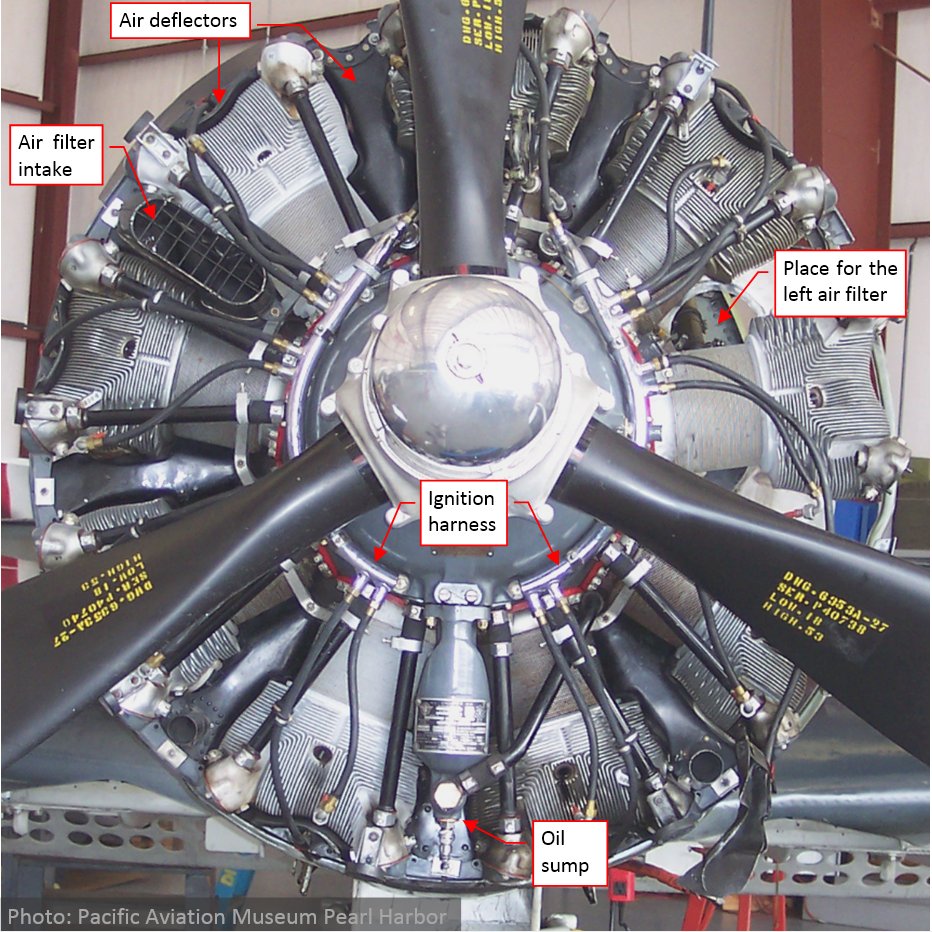
The R-1820 G had been produced for over two decades, not only by the Curtiss-Wright, but also (under license) by Lycoming, Pratt & Whitney Canada, and Studebaker Corporation. Thus various less important details of this engine “evolved” during this period. In this post I would like to highlight some of these differences. I will focus on the forward part of this engine, because at this moment I am going to create a simpler model of the “Cyclone”, intended for the general, “outdoor” scenes. Inside the closed NACA cowling, you can see only its forward part. (Thanks to the air deflectors, placed between the cylinders - see picture above). In such an arrangement, the visible elements are: the front section of the crankcase, cylinders, ignition harness, and the variable-pitch propeller governor. While the front section of the R-1820 crankcase remained practically unchanged in all versions, and the governor depends on the propeller model, I could focus on the cylinders and their ignition harness.
Identification of the version differences is the basic step, because otherwise you can build a model of non-existing object that incorporates features from different engine variants.
BTW: do you know, that the R-1820 design had remarkably long life? The United States factories produced the last batch of these engines in 1964. The metric version of the earlier “F” model had been produced in Soviet Union under Wright’s license since 1934. A few years later Soviet engineers developed its enhanced version: Ash-62 (resembling the “G” model of the “Cyclone”). Ash-62 was widely used in 20th century aircraft of the former eastern block (especially – in the popular Antonov An-2), and had been produced under Soviet license in many countries. Actually the last factory that still produces these engines is PZL WSK-Kalisz in Poland. They provide new units for the last flying DC-3s, An-2s, and M-18s, as well as the overhauling services. Who knows, if this “eastern branch” of the R-1820 will last long enough to celebrate the 100th anniversary of the famous Wright design?
While looking for the reference materials, I have also found an interesting article about the development of air-cooled aviation engines (more precisely, their most important parts: cylinders). I think that it provides a valuable “technical context” for the visual differences that I am describing below.
Searching for the reference photos, I have identified two basic variations of the “Cyclone” cylinder shape:
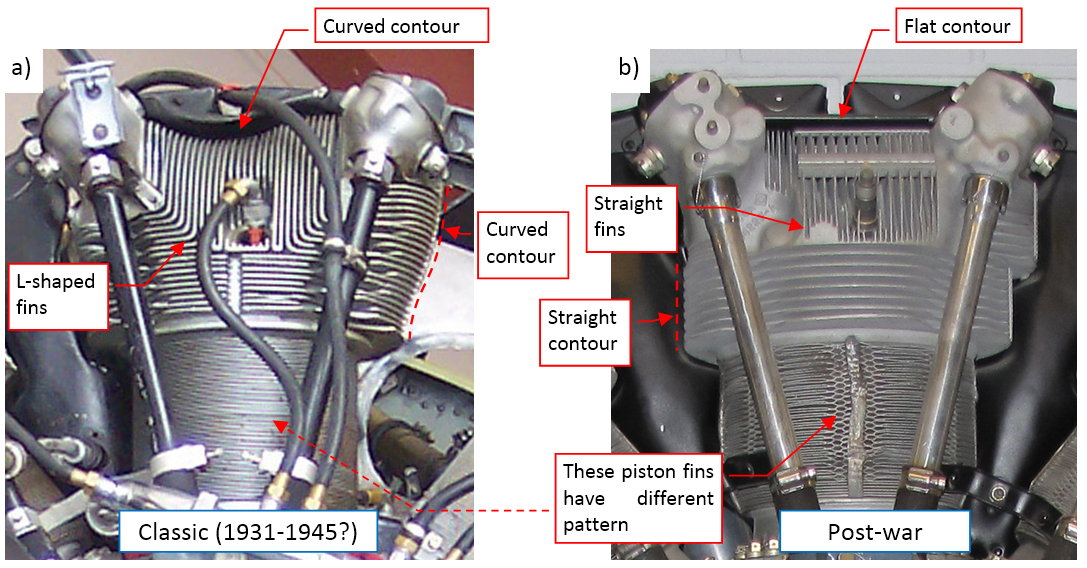
Figure "a" above shows the classic version, produced to the end of the WW2, while the cylinder from Figure "b" comes from the post-war production. I will refer this earlier one as the “classic” version. This is the engine used in all SBDs. You can quickly identify this version by the characteristic “L”-shaped fins on its cylinder head (Figure "a"). The “classic” head has also curved contours, while the head of the post-war version has different style, and its contour is based on the straight lines. Both heads are aluminum die-casts. The critical element in this design was the overall area of their fins. Greater cooling area of the cylinder head allows you to obtain more power from the same piston volume. Thus the fins of the “classic” head are small wonders of the 1930s metallurgy: they are evenly spaced at 0.2” (5mm) along the head, and the widths of their tips do not exceed 0.05” (1.2mm). The fin at its base is about 0.1” (2.5mm) wide. Die-casting of such an object is extremely difficult. It requires not only the “written down” engineering knowledge, but also individual artisanship of the key workers. Note that the spaces between the fins of the post-war head are two times wider than in the “classic” version. However, between each pair of these “full-size” fins there is a smaller, much shorter “inner” fin. It is much easier to die-cast such a head. I suppose that the post-war heads are cast from an aluminum alloy that has better heat transfer characteristics. It would allow their cylinders to maintain similar power output using somewhat smaller cooling area.
The cylinders of the last R-1820 versions had yet another, conical shape:
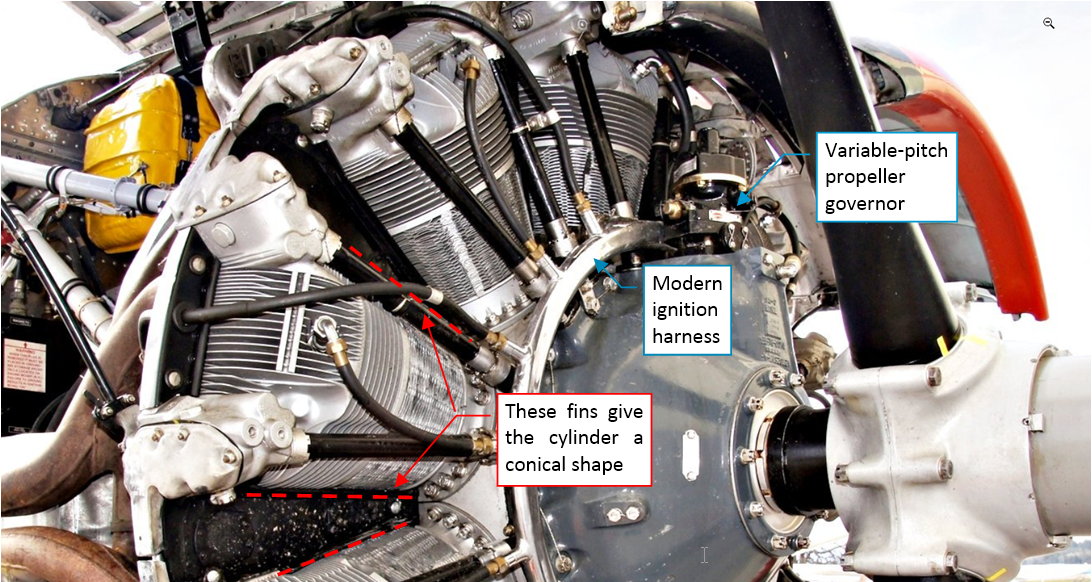
In this photo you can also see here the propeller governor (in the first photo in this post it is hidden behind the propeller blade), and another version of the ignition harness.
The “classic” and the “post-war” cylinder heads have different orientations of their intake openings, which results in different shape of the intake pipes:
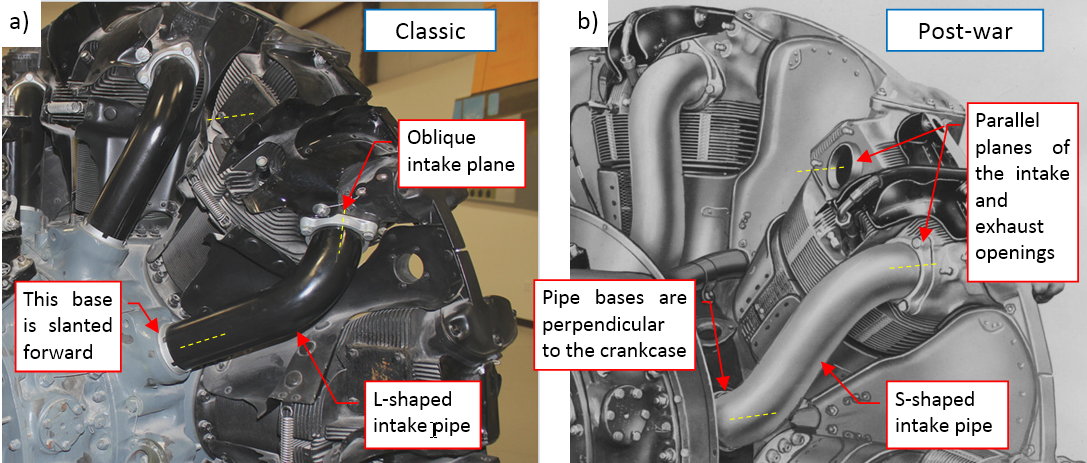
The classic version has a simpler, L-shaped intake pipe, which fits to the oblique opening of the intake valve (Figure "a", above). In the post-war version planes of both valve openings (exhaust and intake) are parallel (Figure "b", above), thus the intake pipe has a more complex shape (resembling “S”).
In fact, Figure "b" above shows the smaller, 7-cylinder version of the Wright Cyclone (R-1300). However, it used the same cylinder and intake ducts as the late R-1820. (I just could not find a shot similar to the Figure "a" of the late R-1820 version, so I used the picture of its “smaller brother” instead).
There are also minor differences in the rocker covers:
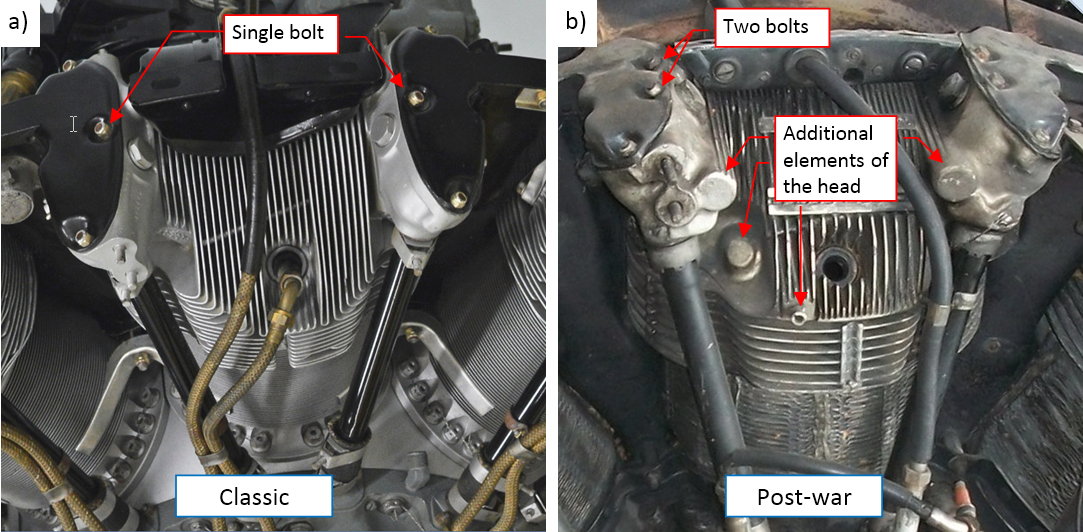
The classic version has simpler, four-bolt rocker cover (Figure "a", above), while the post-war covers uses two bolts more. The head of the post-war engine has some additional features (Figure "b", above), which do not exist in the classic head.
Finally, the ignition harness:
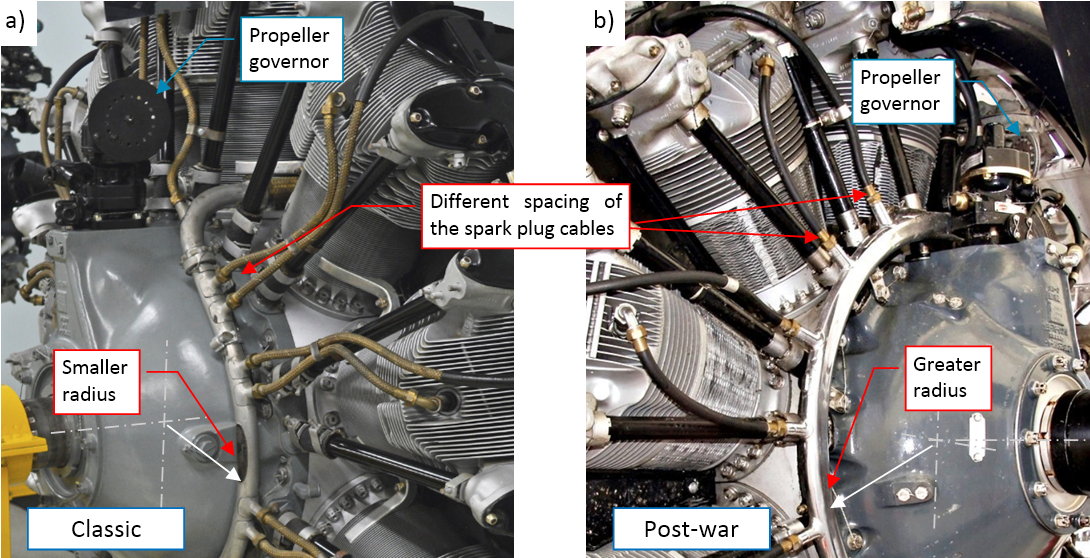
Classic ignition harness has a “collar” shape, smaller radius, and individual spark plug cables organized in pairs (Figure "a"). Post-war harness has a ring shape, somewhat greater radius, and evenly spaced spark plug cables (Figure "b"). Although each of these photos is taken from different side, it seems that both versions use the same propeller governor.
Having all these issues identified, I could select appropriate reference drawings. They came from “Cyclone 9GC Overhaul Manual”, published in 1943. I expect that even the simplified model of such an engine can have many hundred thousand faces, thus I decided to build it in a separate Blender file. I use the same “scale” as in the SBD model: 1 unit = 1 inch. When it is ready, I will import it into the SBD model.
In this new Blender file I decided to give chance to the alternate method of setting up the blueprints: using Empty objects with the attached image:
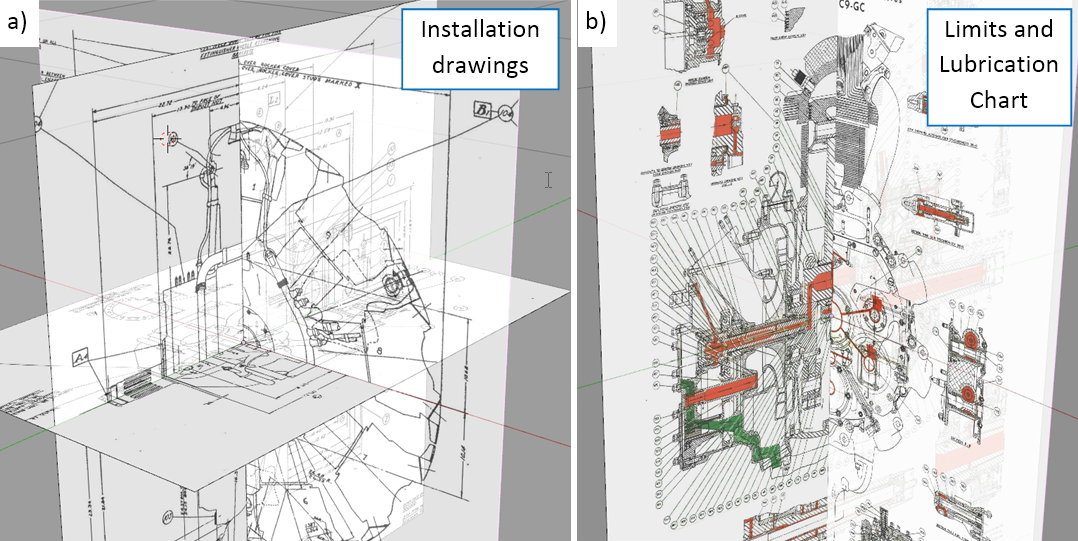
First I placed on the perpendicular planes the four views of the original installation drawings (Figure "a", above). Note that they contain a lot of the explicit dimension values – such information is an invaluable help in recreating this engine.
I quickly realized that the Empty objects with the reference images allow you to use simultaneously several alternate sets of the blueprints. Just place each of them on a separate layer. It will be a great tool in the Blender 2.8, which has to have unlimited number of layers. While working in the actual Blender 2.7, I placed these planes on layers 7…10, practically reserving them for the reference pictures. The second blueprint set contains the images from the original “Limits and Lubrication Chart” (Figure "b", above). These two views (side and rear view) are much more detailed than the installation drawings (presented in Figure "a", above). Of course, these images do not match each other in a perfect way: there always are some differences. However, I did not fix them, as in the case of the SBD planes, because all the key dimensions of this engine are specified in the installation drawings. I will just use these explicit values.
Following the standard of my posts, I am enclosing the current state of the source *.blend file. While there is no model, yet, you look inside to check the arrangement of the reference pictures. Next week I will report the first stages of building this model: forming the central crankcase and the basic cylinder shape. (Cylinders of this engine are identical with each other. Once you prepare one of them, you can quickly “populate” the crankcase with its eight clones. However, as you will see in the next posts, the die-cast, air-cooled cylinder head is one of the most complex objects to model…).
[1]The SBD Dauntless was a new implementation of the US Navy carrier doctrine, worked out in the preceding decade: in the clash of the carriers always wins those, who first finds carriers of their opponent. In fact, the best option was to find, report, and immediately make the first attack – that’s why all SBDs carried a 500-pound bomb on their scout missions